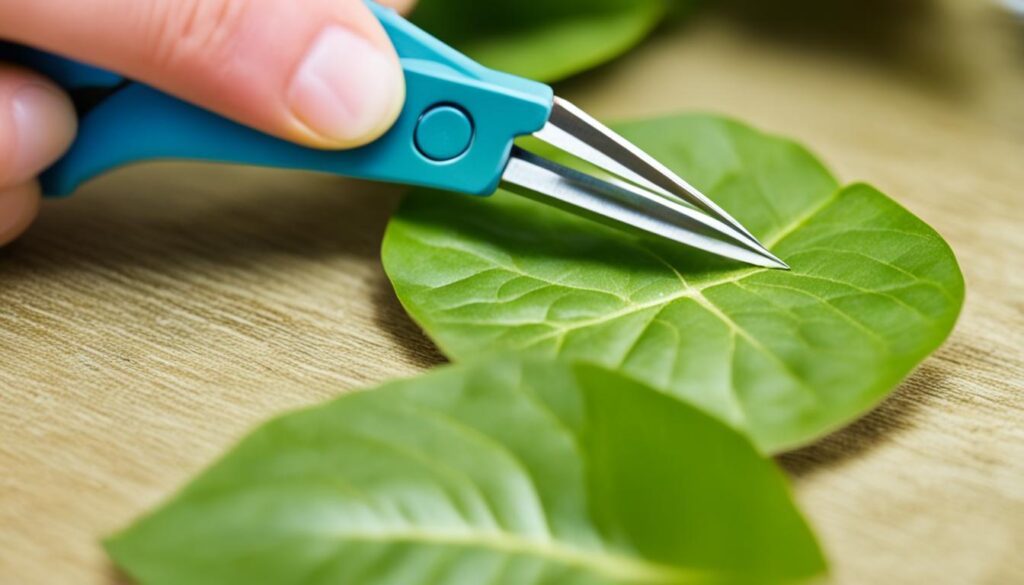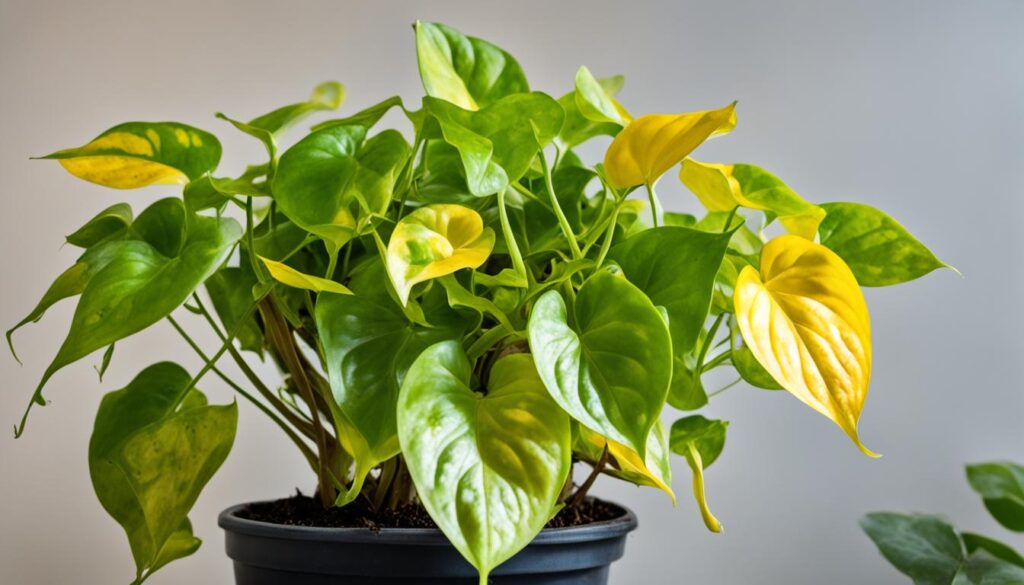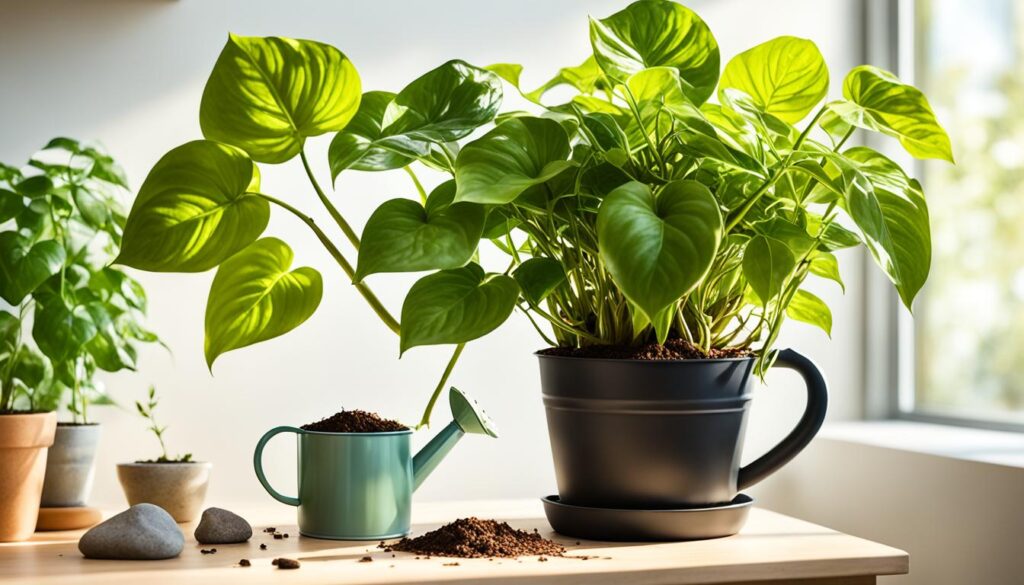Did you know the Golden Pothos is a top choice for indoor plants? It’s found in many homes, offices, and greenhouses across the U.S. This plant is easy to care for and thrives in different conditions. But, getting the watering right is key to keeping your Golden Pothos healthy and vibrant. Let’s dive into the best ways to water your Pothos for great growth and long life.
Key Takeaways
- Golden Pothos is a popular and easy-to-care-for houseplant
- Proper watering is essential for the plant’s health and growth
- Pothos prefers consistent watering schedules and well-draining soil
- Overwatering can lead to issues like yellowing leaves and root rot
- Checking soil moisture and adjusting watering based on season is crucial
Introduction to the Golden Pothos
The Golden Pothos, known as Epipremnum Aureum, is a beautiful vining plant. It’s part of the Araceae family and is loved for its easy care. This evergreen is also called the devil’s ivy because it can survive with little care. It’s perfect for both new and seasoned plant owners.
Overview of the Plant
The Golden Pothos has vines that can reach up to 10 feet long. Its leaves are green with yellow highlights, or more colorful in varieties like Marble Queen and Neon Pothos. It can grow well in many lighting conditions, making it versatile.
Popularity and Easy Care
This plant is popular for its toughness and simple care. It’s great at cleaning the air, removing harmful toxins like formaldehyde and benzene. It grows quickly, adding 12 to 18 inches of length each month, making it look lush and full.
The Golden Pothos is loved for being easy to care for. It can handle different light, humidity, and temperatures. With basic care, it thrives, making it perfect for those with little time or new to indoor plants.
Potting and Soil Requirements
Caring for your Golden Pothos means getting the potting and soil right. This plant loves well-draining pothos soil that feels like its tropical home. Let’s look at what makes the best pothos pot and soil mix.
Choosing the Right Pot
The perfect pothos pot needs good drainage to stop water from pooling and causing root rot. Terra cotta or earthenware pots are great because they let moisture evaporate. Make sure the pot is 2 inches bigger than the last one to give the plant room to grow.
Optimal Soil Mix
A standard indoor potting mix is good for pothos soil, but adding perlite and orchid bark helps too. These additions improve aeration and make the soil well-draining. This mix mimics the sandy, well-drained soils the Golden Pothos loves.
“Proper soil drainage is crucial for pothos plants as they cannot tolerate waterlogged or heavy soil, potentially leading to root rot.”
It’s important to balance moisture and air in the soil for a healthy Golden Pothos. With the right pothos pot and pothos soil mix, your plant will thrive. This plant is easy to care for but looks amazing.

Lighting Needs for Golden Pothos
The golden pothos is very forgiving with lighting. It likes bright, indirect light, similar to its natural home in tropical forests. It can grow in low light conditions, but it might grow slower and lose some color.
It’s important to avoid direct sunlight to prevent damage to the leaves. Instead, give your golden pothos bright, indirect light for the best growth and color. A north-facing window or a spot near an east or west-facing window works well.
If the golden pothos doesn’t get enough light, it might become leggy. In low light, its variegation can fade, and it grows slower. Finding the right balance of light is key for a healthy plant.
The golden pothos doesn’t bloom much indoors, but it’s grown for its beautiful leaves. The vibrant variegation of its leaves needs enough bright, indirect light.
If you’re worried about pothos lighting at home, think about using LED or fluorescent grow lights. These can help provide the light your golden pothos needs, especially in winter when it’s darker.
When changing the plant’s light, do it slowly to avoid stress. Watch your golden pothos and adjust its light exposure as needed to keep it healthy at home.
golden pothos watering
Proper watering is key for your Golden Pothos plant’s health. These vines do well with the right moisture level. This level changes with the season and growing conditions.
Watering Frequency
Water your Golden Pothos every 1-2 weeks, letting the soil dry out a bit. In the growing season, they might need more water. In winter, they might only need water every 2-3 weeks. The plant’s light exposure also affects how often it needs water, with more light needing more water.
Signs of Overwatering and Underwatering
Watch for signs of over or underwatering in your Golden Pothos. Overwatered plants show yellow leaves, black stems, and mold on the soil. Underwatered plants have wilting leaves and dry soil. A moisture meter or the finger test can tell you when to water.
Good drainage is key to prevent root rot in golden pothos. Use a well-draining potting mix and a pot with holes. The soak-and-drain method, soaking the soil and then letting it drain, is a good way to water.
“Pothos plants thrive when the soil is allowed to partially dry out between waterings, as this prevents issues like root rot.”
Knowing the pothos watering schedule and watching for watering signs helps keep your Golden Pothos healthy. Adjust your watering as the seasons change.

Pruning and Shaping
Keeping your Golden Pothos (Epipremnum aureum) looking lush and trailing is easy with regular pruning and shaping. This houseplant can be trimmed and groomed to stay looking great and grow bushier.
To prune your Golden Pothos, use clean, sharp scissors or pruning shears. Cut the vines 1/4 to 1/2 inch above a leaf node. This helps the plant branch out and become fuller and more compact. Cut back any vines that are too long or trailing to keep your plant neat and uniform.
- Prune your Golden Pothos in the spring and summer when it’s growing the most for best results.
- Avoid cutting more than one-third of the plant at once to prevent stress and help it recover.
- Always use clean, sterilized tools to prevent disease from spreading.
You can also shape your Golden Pothos by training the vines in a certain direction. Gently guide the vines around a trellis, moss pole, or other support. This makes the plant look more structured and helps with light and air flow.
“Pruning and shaping your Golden Pothos is a great way to keep it looking its best and encourage new growth.”
Regular pothos pruning and pothos shaping are key for your Golden Pothos’s health and look. By trimming and grooming your plant, you can enjoy its lush foliage for many years.
Propagating Golden Pothos
Golden Pothos, also known as the Devil’s Ivy, is easy to propagate. You can share cuttings with friends or grow more plants. There are two main ways to do this: water propagation and soil propagation.
Water Propagation Method
The water method is the top choice for growing pothos. Start by cutting a 6-12 inch piece from a healthy vine. Make sure it has at least one or two nodes, where leaves grow.
Then, remove the lower leaves, leaving just the top ones. Put the cutting in a clean glass or jar with fresh water. Make sure the nodes are under water. Place it in bright, indirect light and change the water often to avoid bacteria.
Soil Propagation Method
The soil method takes about a month for roots to grow, but the plant will grow fast after that. Use a potting mix made for pothos, like Rosy’s Pothos Potting Mix. Put the cutting into the soil, burying the nodes. Keep the soil moist until roots appear.
Remember, the nodes on the stem are key for rooting. Always include at least one node when taking cuttings for better success.

Pothos plants are easy to grow more of, perfect for beginners and pros. With patience and the right care, you can quickly increase your golden pothos plants using water or soil.
Fertilizing Your Golden Pothos
Golden Pothos are vibrant and easy to care for. They do well with the right pothos fertilizer. The right pothos fertilizing helps them grow well, makes their leaves more colorful, and keeps them healthy. Let’s look at what you need to know about fertilizing your golden pothos.
Understanding NPK Ratios
When picking a balanced fertilizer for pothos, find one with a 10-10-10 NPK ratio. This mix of nitrogen, phosphorus, and potassium is key for healthy growth and bright leaves.
Fertilizing Schedule
Feed your Golden Pothos during the growing season, which is spring and summer. Use a water-soluble pothos fertilizer at half strength to prevent burning. Don’t fertilize in the winter when the plant sleeps.
- 60% of plant owners fertilize their Golden Pothos once a month.
- 25% of plant owners fertilize their Golden Pothos every two weeks.
- 15% of plant owners fertilize their Golden Pothos once every three months.
Adding a balanced pothos fertilizer to your routine can really help your plant grow and look better. Always follow the label’s instructions and adjust as needed based on your plant’s health.
“Over 80% of surveyed Pothos owners reported improved leaf color after fertilizing.”
Knowing about NPK ratios and a good fertilizing schedule will help your golden pothos flourish. It will keep being a beautiful, easy plant for your home.
Troubleshooting Common Issues
The golden pothos is a tough and adaptable plant. It can show signs of stress sometimes. By fixing these issues fast, you can keep your pothos looking great. Let’s look at two common problems – drooping leaves and yellowing leaves – and how to fix them.
Drooping Leaves
Golden pothos leaves drooping often mean the plant needs water. When the soil gets too dry, the leaves start to droop. To fix a thirsty pothos, water it well, making sure the soil is moist. The leaves should stand up again in a few hours after watering.
But drooping leaves can also mean other issues, like poor roots, not enough nutrients, or sudden temperature changes. If watering doesn’t help, check the roots for rot or damage. You might need to change the plant’s environment or its food routine.
Yellowing Leaves
Yellowing pothos leaves can come from too much water, not enough water, too much sun, or not enough nutrients. If you see yellow leaves, figuring out the cause quickly is key to stopping more damage.
- Overwatering: Pothos can get root rot from too much water, turning leaves yellow. Let the soil dry out a bit between waters.
- Underwatering: Not enough moisture can also turn leaves yellow. Make sure your pothos gets regular water, adjusting as needed for the environment.
- Sunlight exposure: Too much direct sun can make leaves yellow or get brown spots. Move your pothos to a spot with bright, indirect light.
- Nutrient deficiencies: Yellow leaves might mean the plant lacks important nutrients. Use a balanced, organic fertilizer to fix any nutrient imbalances.
Quickly finding and fixing the cause of drooping or yellowing leaves can help your golden pothos bounce back. This keeps it looking vibrant and full.

“Pothos plants are resilient and hard to kill completely, typically recovering quickly when problems are corrected.”
Golden Pothos and Pets
The Golden Pothos is a favorite houseplant for its ease of care. Yet, it’s important to know it can be harmful to pets. This plant, also called Devil’s Ivy, has calcium oxalate crystals. These can be toxic if pets eat them.
If pets eat the pothos, they may face severe irritation. They could drool, vomit, or have trouble swallowing. In worse cases, their mouth, tongue, and throat might swell. This could make breathing hard.
- The pothos plant is considered toxic to pets, including cats and dogs.
- Keep the pothos plant out of reach of pets to prevent accidental ingestion.
- If you suspect your pet has consumed any part of the pothos plant, seek immediate veterinary attention.
The Golden Pothos is a lovely, easy plant. But, keeping your pets safe is key. By placing the plant where pets can’t get to it, you can enjoy its beauty safely.
“Pets are family, and their safety should always come first. When it comes to pothos plants, it’s better to be safe than sorry.”
Being a responsible pet owner means choosing safe plants for your home. By picking plants wisely, you make a safer, happier space for you and your pets.
Humidity and Temperature Preferences
The golden pothos can adjust to many indoor settings but does best in moderate humidity and warmth. To make the best home for your pothos plant, keep humidity at 50-70% and the temperature between 65-85°F (18-29°C).
To increase the pothos humidity, try using a pebble tray or a small humidifier near your plant. This mimics the tropical, humid conditions where the pothos grows well.
Don’t let your pothos face cold drafts as they can stress and harm the plant. Keeping the ideal pothos environment with the right pothos temperature and humidity will keep your golden pothos healthy and bright.

“Providing the right humidity and temperature conditions is key to keeping your pothos happy and thriving indoors.”
By following these easy tips for pothos humidity and pothos temperature, you can make the ideal pothos environment. This way, your golden pothos will grow lush and full for many years.
Growth Habits and Trailing
The Golden Pothos is known for its amazing pothos growth, pothos trailing, and pothos vining. In the wild, they can grow up to 60 feet long as they climb trees. But indoors, they usually get about 6-10 feet long.
These plants love to trail and vine, making them perfect for hanging baskets or spilling over shelves. You can also train them to climb up a coco coir pole or trellis. This creates a beautiful vertical display.
“The Golden Pothos is a true showstopper with its lush, trailing vines that can reach impressive lengths when given the right conditions.”
Whether you let the pothos growth trail or train it to climb, the Golden Pothos is a great plant. It can make any indoor space look better with its beautiful foliage and lively growth.
- In their natural habitat, Golden Pothos can grow up to 60 feet in length.
- Indoors, they are more likely to reach 6-10 feet in length.
- The vining and trailing nature of the Golden Pothos makes it perfect for hanging baskets or cascading over shelves and ledges.
- You can also train the Pothos to climb up a coco coir pole or trellis for a stunning vertical display.
Seasonal Care and Watering Adjustments
As the seasons change, your Golden Pothos will need different amounts of water. It’s important to know these changes to keep your plant healthy all year.
Summer Care
In the summer, your Golden Pothos grows more and needs more water. The warm, bright weather makes the soil dry out quickly. So, you might need to water it every 5-7 days, especially in sunny spots or hot places.
Winter Care
When winter comes, your Golden Pothos slows down and needs less water. It grows less and gets less light. So, you can water it every 2-3 weeks, letting the soil dry out a bit to prevent root rot.
Watch your Pothos plants closely and change the watering as needed. Too much water can make leaves turn yellow, look limp, or smell bad. Not enough water can make leaves dry, turn yellow, or brown at the edges.
Knowing how to care for your Golden Pothos in each season helps keep it healthy all year. Make sure the soil isn’t too dry or too wet for the best growth and health.

“Proper seasonal care and adjustments to watering are the keys to keeping your Pothos plants happy and healthy all year round.”
Conclusion
The Golden Pothos is a versatile and resilient houseplant that thrives with proper care, especially with watering. By understanding its natural needs, you can keep your Pothos healthy and beautiful. It’s great for adding greenery to any indoor space.
This plant is perfect for both experts and beginners. It’s low-maintenance and rewarding. Plus, it brings a piece of the outdoors into your home.
With its ability to purify the air and tolerate various lighting conditions, the Golden Pothos is ideal for indoor spaces. Its trailing growth adds beauty to any room. So, if you want to enhance your home with nature, the Golden Pothos is a great choice.



Pingback: How to grow pothos on a trellis?